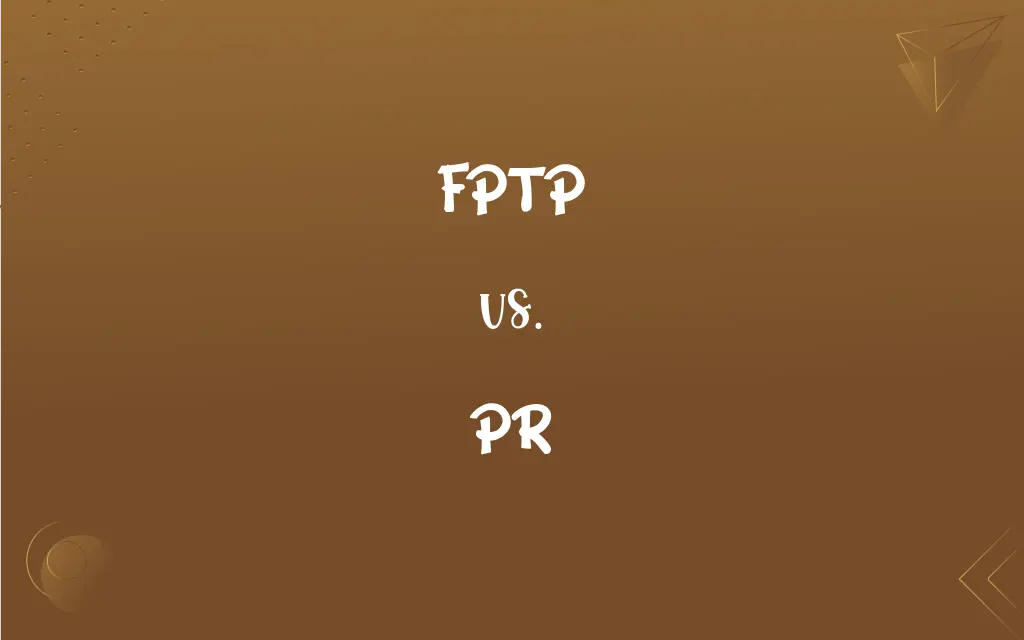FPTP vs. PR: What's the Difference?
Edited by Aimie Carlson || By Harlon Moss || Published on February 12, 2024
FPTP (First Past the Post) is an electoral system where the candidate with the most votes wins, while PR (Proportional Representation) allocates seats based on the proportion of votes each party receives.

Key Differences
FPTP (First Past the Post) is a simple, majoritarian electoral system where the candidate who receives the most votes in a constituency wins. It’s commonly used in countries like the UK and USA for legislative elections. PR (Proportional Representation), on the other hand, is designed to allocate seats in proportion to the total number of votes each party receives, used in many European countries.
In FPTP, the focus is on individual candidates rather than political parties. It often leads to a two-party system, as smaller parties struggle to gain seats. PR emphasizes political parties over individual candidates and typically results in multi-party systems, as even smaller parties can gain representation proportional to their vote share.
FPTP can lead to ‘wasted votes,’ where votes for losing candidates or votes beyond what is needed to win a seat don’t contribute to representation. PR seeks to minimize wasted votes, ensuring that almost all votes contribute towards representation in the legislature.
FPTP tends to produce majority governments, which can lead to more decisive and stable governance, but might not reflect the diverse views of the electorate. PR, while offering a more representative outcome, can lead to coalition governments, which some argue brings compromise and consensus politics.
In FPTP, constituencies can have varied representation as it's based on winning individual local contests, which might not reflect national vote percentages. PR aims for a legislature that mirrors the overall vote distribution, offering a more balanced representation of the electorate’s views.
ADVERTISEMENT
Comparison Chart
Focus
Individual candidates
Political parties
System Type
Majoritarian
Proportional
Common Result
Two-party system, majority governments
Multi-party system, coalition governments
Vote Utilization
Can lead to wasted votes
Minimizes wasted votes
Representation
May not reflect diverse views
More reflective of voter preferences
ADVERTISEMENT
FPTP and PR Definitions
FPTP
FPTP can marginalize smaller parties.
In FPTP, it's hard for small parties to win seats even with significant public support.
PR
PR allocates seats based on the proportion of votes received.
In PR, if a party gets 30% of the votes, it gets roughly 30% of the seats.
FPTP
FPTP can lead to tactical voting.
Voters might choose the lesser of two evils in FPTP to prevent their least favorite candidate from winning.
PR
PR aims for a legislature that mirrors voter preferences.
PR provides a more accurate representation of the electorate’s political spectrum.
FPTP
FPTP is an electoral system where the highest vote-getter wins.
In FPTP, a candidate can win with just one more vote than their closest rival.
PR
PR can be complex and involve various voting mechanisms.
PR systems may use party lists or transferable votes to allocate seats.
FPTP
FPTP often results in a clear winner, simplifying governance.
FPTP can lead to a majority government even if the party doesn’t win a majority of votes.
PR
PR promotes multi-party representation.
Smaller parties have a better chance of winning seats under PR.
FPTP
FPTP is straightforward and easy to understand.
Voters in FPTP simply mark their preferred candidate on the ballot.
PR
PR can lead to coalition governments.
No single party achieving a majority under PR often results in coalitions.
FAQs
Is FPTP used for presidential elections?
Yes, in countries like the USA.
What does FPTP stand for?
First Past the Post.
Does FPTP lead to majority governments?
Yes, it often does.
How does FPTP affect smaller parties?
It often disadvantages them in winning seats.
What does PR stand for?
Proportional Representation.
Can FPTP result in disproportionate representation?
Yes, winners can govern without a majority of the popular vote.
Is PR more representative than FPTP?
Generally, yes, as it reflects a wider range of voter preferences.
Is PR complex to administer?
It can be, depending on the specific system used.
Are there different types of PR?
Yes, including party-list PR and Single Transferable Vote (STV).
Why might a country choose FPTP?
For its simplicity and tendency to produce decisive outcomes.
Does FPTP favor established parties?
Yes, it tends to reinforce the dominance of larger parties.
Are PR systems used in national elections?
Yes, in many European and other parliamentary systems.
Do countries using PR have more political parties?
Yes, it typically results in multi-party systems.
Can PR lead to unstable governments?
Sometimes, due to coalition politics.
Does FPTP encourage strategic voting?
Yes, voters may choose not their first preference but the most viable option against their least favorite.
How does PR handle geographic representation?
Some PR systems combine proportional representation with geographic constituencies.
Can FPTP be combined with PR?
Yes, some countries use a mixed system with elements of both.
How does PR affect voter engagement?
It can increase engagement by making more votes count towards representation.
Does PR always result in coalitions?
Often, but not always.
Can FPTP be unfair to large parties?
Potentially, if they win many areas by small margins but lose others by large margins.
About Author
Written by
Harlon MossHarlon is a seasoned quality moderator and accomplished content writer for Difference Wiki. An alumnus of the prestigious University of California, he earned his degree in Computer Science. Leveraging his academic background, Harlon brings a meticulous and informed perspective to his work, ensuring content accuracy and excellence.
Edited by
Aimie CarlsonAimie Carlson, holding a master's degree in English literature, is a fervent English language enthusiast. She lends her writing talents to Difference Wiki, a prominent website that specializes in comparisons, offering readers insightful analyses that both captivate and inform.







































































